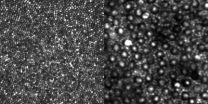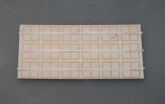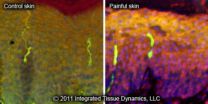(Press-News.org) WASHINGTON, June 8—Scientists today reported that the tiny light-sensing cells known as rods have been clearly and directly imaged in the living eye for the first time. Using adaptive optics (AO), the same technology astronomers use to study distant stars and galaxies, scientists can see through the murky distortion of the outer eye, revealing the eye's cellular structure with unprecedented detail. This innovation, described in two papers in the Optical Society's (OSA) open access journal Biomedical Optics Express, will help doctors diagnose degenerative eye disorders sooner, leading to quicker intervention and more effective treatments.
"While therapies are only emerging, the ability to see the cells you are trying to rescue represents a critical first step in the process of restoring sight," says researcher Alfredo Dubra of the University of Rochester in New York, who led the team of researchers from Rochester, Marquette University, and the Medical College of Wisconsin (MCW), Milwaukee. "It's impossible to overemphasize how important early detection is to eye disease."
"One of the major hurdles in detecting retinal disease is that by the time it can be perceived by the patient or detected with clinical tools, significant cellular damage has often already occurred," adds team member Joseph Carroll of MCW.
The breakthrough that is ushering in a new era of eye disease research, diagnosis, and treatment is an improved design of a non-invasive adaptive optics imaging system. Dubra and his colleagues were able to push the device's resolution to its optical limits of nearly 2 microns (a micron is 1/1,000 of a millimeter), or the approximate diameter of a single rod in the human eye.
Rods are much more numerous than cones and are vastly more sensitive to light. With the optical design method successfully demonstrated by Dubra's team, even the smallest cone cells at the center of the retina, known as the foveal center, can be seen very clearly. Rods can be seen clearly in a less central retinal location. (See Fig. 1)
"This is a really exciting breakthrough," says Steve Burns, a professor in the School of Optometry at Indiana University, who is not involved in the Biomedical Optics Express research. "Imaging contiguous rod mosaics will allow us to study the impact of a whole new class of blinding disorders on the retina. Since many of the eye diseases most amenable to intervention affect the rods, this should become a major tool for determining what treatments work best for those disorders."
De-twinkling Stars, Visualizing Rods
In astronomy, adaptive optics is able to correct for the blurring effect of Earth's atmosphere, effectively removing the "twinkling" from starlight and rendering cosmic objects as very sharp points of light. To achieve this correction, the AO system requires a reference point—either a bright, nearby star or an artificial "guide star" produced in the upper atmosphere by lasers mounted on a telescope. By monitoring that reference point, AO systems use a deformable mirror to create the exact but opposite distortion that is happening in the atmosphere. The result is a clearer image with much greater resolution.
Just as light passing through the atmosphere becomes bent and distorted, so too does light passing through the front part of the eye. This distortion is inconsequential on the scale of human vision, but poses a significant barrier in the microscopic realm of medical imaging.
In 1997, David Williams of the University of Rochester led the group that first demonstrated using AO technology to study the interior of the human eye. In this system, called an adaptive optics ophthalmoscope, a laser creates a reference point that is used to correct the blurring of the image obtained with a fundus camera. Today the fundus camera is commonly replaced by a second laser for imaging, which is known as an adaptive optics scanning laser ophthalmoscope. By moving the laser point across the retina and correcting the distortion along the way, line-by-line an accurate image emerges, in much the same way that a CRT monitor renders an image.
Though earlier AO systems could effectively image cones and have become a mainstay of high-resolution retinal imaging research, the smaller rods, which outnumber cones 20 to 1 in the retina, have eluded clear and contiguous observation in the living eye.
Breakthrough Design
The breakthrough in the design of the AO instrument that led to clearly visualizing rods was, according to Dubra, "embarrassingly simple, and relied on well-known equations and concepts." By simply folding the spherical mirrors that act as lenses in the instrument into a three-dimensional structure, the image quality of the retina was improved sufficiently to clearly resolve the contiguous rod mosaic, as well as the entire cone mosaic at the foveal center.
"By combining careful optical engineering, excellent adaptive optics control, and knowledge of the visual system the authors have made a major advancement in both biomedical imaging and vision science," says Burns.
Improving Patient Care
According to the researchers, their next step is to develop a clinical model that could be widely available. A related task is simplifying and teaching the art of interpreting AO images to guide clinical decisions about diagnosis and treatment.
When that occurs, hopefully in the next 5 to 10 years, doctors will likely be able to routinely peer into a living human eye with such precision and clarity that they will be able to see and evaluate individual rods—and do three things never before possible: accurately describe the physical presentation of specific rod disorders—the "phenotype" of a disease, intervene with early treatment at the first sign of disease, and even determine how individual cells are responding to a specific treatment.
"That's what's really exciting about this imaging device: it can really make a difference in a patient's life," says Carroll. "The ability to now resolve these cells opens up new possibilities for improving care that researchers have been anticipating for a long time—such as using the information in these retinal images to aid in targeting, delivering, and evaluating therapies."
INFORMATION:
Paper: "Non-invasive imaging of the human rod photoreceptor mosaic using a confocal adaptive optics scanning ophthalmoscope" Biomedical Optics Express, Volume 2, Issue 7, pp. 1864-1876. http://www.opticsinfobase.org/boe/abstract.cfm?uri=boe-2-7-1864
Paper: "Reflective afocal broadband adaptive optics scanning ophthalmoscope" Biomedical Optics Express, Volume 2, Issue 6, pp. 1757-1768. http://www.opticsinfobase.org/boe/abstract.cfm?uri=boe-2-6-1757
The papers appear as part of a special feature issue of Biomedical Optics Express on "Cellular Imaging of the Retina."
EDITOR'S NOTE: High-resolution images and a video of Dubra (http://bcove.me/e75lbyi2) explaining the importance of the research are available. Contact Angela Stark, astark@osa.org or 202.416.1443.
About Biomedical Optics Express
Biomedical Optics Express is OSA's principal outlet for serving the biomedical optics community with rapid, open-access, peer-reviewed papers related to optics, photonics and imaging in the life sciences. The journal scope encompasses theoretical modeling and simulations, technology development, and biomedical studies and clinical applications. It is published by the Optical Society and edited by Joseph A. Izatt of Duke University. Biomedical Optics Express is an open-access journal and is available at no cost to readers online at http://www.OpticsInfoBase.org/BOE.
About OSA
Uniting more than 106,000 professionals from 134 countries, the Optical Society (OSA) brings together the global optics community through its programs and initiatives. Since 1916 OSA has worked to advance the common interests of the field, providing educational resources to the scientists, engineers and business leaders who work in the field by promoting the science of light and the advanced technologies made possible by optics and photonics. OSA publications, events, technical groups and programs foster optics knowledge and scientific collaboration among all those with an interest in optics and photonics. For more information, visit www.osa.org.
Historic first images of rod photoreceptors in the living human eye
Adaptive optics technology likely to spur sight-saving interventions, usher in new era of eye disease research, diagnosis and treatment
2011-06-09
ELSE PRESS RELEASES FROM THIS DATE:
Southwest Binding & Laminating Adds PSA Overlaminates & Mounting Adhesives to Lineup
2011-06-09
Southwest Binding & Laminating, a St. Louis, MO based manufacturer and distributor of document finishing products is pleased to announce the launch of it's PSA Overlaminate (ProGuard) and Mounting Adhesives (ProBond) to service new and existing customers.
"The Wide Format Printing market has seen tremendous growth and popularity," said Mark Mercer, President and CEO of Southwest Binding & Laminating. "PSA Overlaminates and Mounting Adhesives is a great addition to Southwest's product mix, in our continued efforts to better serve our customers."For ...
NIST tunes 'metasurface' with fluid in new concept for sensing and chemistry
2011-06-09
Like an opera singer hitting a note that shatters a glass, a signal at a particular resonant frequency can concentrate energy in a material and change its properties. And as with 18th century "musical glasses," adding a little water can change the critical pitch. Echoing both phenomena, researchers at the National Institute of Standards and Technology (NIST) have demonstrated a unique fluid-tuned "metasurface," a concept that may be useful in biomedical sensors and microwave-assisted chemistry.
A metasurface or metafilm is a two-dimensional version of a metamaterial, ...
Gary Rabine Speaks at Crain's Fast Fifty Breakfast
2011-06-09
The Rabine Group is proud to announce that its CEO and founder, Gary Rabine, was invited to speak at Crain's Fast Fifty Breakfast along with other successful entrepreneurs from Crain's Fast Fifty Growing Companies list. The event will be held on Tuesday, June 14, 2011 at the Westin River North hotel in Chicago.
The prestigious Fast Fifty Growing Companies list is an annual report published by Crain's Chicago featuring the fastest-growing public and private companies in the Chicagoland area based on five-year revenue growth. Last year, the Rabine Group ranked No. 12 with ...
Distracted driving data and laws to prevent it don't match up
2011-06-09
Cell phone distractions account for more than 300,000 car crashes each year. As a result, most states have put laws in place to limit or prohibit the use of mobile devices while driving. But a new study led by Temple University finds a widening gap between the evidence on distracted driving and the laws being passed to address the problem.
The new study, published this month in the American Journal of Preventive Medicine, is the first comprehensive collection and coding of state laws attempting to address the public health risk posed by distracted driving.
Lead author ...
NIST 'catch and release' program could improve nanoparticle safety assessment
2011-06-09
Depending on whom you ask, nanoparticles are, potentially, either one of the most promising or the most perilous creations of science. These tiny objects can deliver drugs efficiently and enhance the properties of many materials, but what if they also are hazardous to your health in some way? Now, scientists at the National Institute of Standards and Technology (NIST) have found* a way to manipulate nanoparticles so that questions like this can be answered.
The team has developed a method of attracting and capturing metal-based nanoparticles on a surface and releasing ...
Best Place in the USA to Celebrate July's National Ice Cream Month
2011-06-09
As the nation prepares to celebrate National Ice Cream Month this July, there's no place better to experience the creamy confection than Harrison County. Here, a trio of old-fashioned ice cream parlors and soda fountains draw sweet-toothed visitors of all ages to the southern Indiana town of Corydon.
Palate-Pleasing Prescription
Recently made famous with the wildly popular viral nature of their online commercial (http://bit.ly/cGNJuu), the classic soda fountain tucked inside Butt Drugs returns visitors to the laid-back days before cell phones and MP3s. Locals and out-of-towners ...
Temperature tracking device for packages may have climate metrology applications
2011-06-09
National Institute of Standards and Technology (NIST) researchers are working to reduce the uncertainty associated with climate-change measurements using a mobile temperature-sensing technology made for tracking delicate or perishable, high-value packages in transit. Developed by international shipper FedEx and tested with help from NIST, the device connects to cell phone networks to provide users with near real-time information on the package's precise location, temperature, humidity, pressure, acceleration, elevation and exposure to light.
Senseaware tag
Developed by ...
Researchers discover potential cause of chronic painful skin
2011-06-09
June 6, 2011 – (Rensselaer, N.Y., USA) – A new study may explain why only 50% of patients experiencing chronic nerve pain achieve even partial relief from existing therapeutics. The study, published in the June 6 online version of the international research journal PAIN, reveals that certain types of chronic pain may be caused by signals from the skin itself, rather than damage to nerves within the skin, as previously thought.
A Medical Mystery
For years, researchers have known that increased amounts of a molecule called Calcitonin Gene-Related Peptide (CGRP) is ...
VELUX Solar Water Heating System and Sun Tunnel Skylight in Concept Home
2011-06-09
A VELUX America solar water heating system and Sun Tunnel skylight are included in the KB Home GreenHouse: An Idea Home Created with Martha Stewart, at the 2011 International Builders' Show in Orlando.
The home is slated to be the first net-zero energy, single-family home in the Builder Magazine Concept Home series. The KB Home GreenHouse will also demonstrate to consumers that this environmentally friendly home not only saves energy and water through the use of solar and thermal systems and meeting EPA's WaterSense for new homes specifications, but can also save them ...
VELUX Expands Solar Water Heating Product Line in U.S.
2011-06-09
VELUX America has expanded its solar water heating product line in the U.S. to include packaged solar water heating systems for homeowners in all markets across the country.
Jim Cika, manager, solar products for VELUX America, says VELUX has three major additions to the solar product line that will open the solar water heating market to U.S. homeowners. He says that the addition of gas backup solar systems, rack mounted collector systems, and smaller size, one-collector/60 gallon tank solar systems, will provide most homeowners with a solar thermal option to meet their ...
LAST 30 PRESS RELEASES:
Heart-brain connection: international study reveals the role of the vagus nerve in keeping the heart young
Researchers identify Rb1 as a predictive biomarker for a new therapeutic strategy in some breast cancers
Survey reveals ethical gaps slowing AI adoption in pediatric surgery
Stimulant ADHD medications work differently than thought
AI overestimates how smart people are, according to HSE economists
HSE researchers create genome-wide map of quadruplexes
Scientists boost cell "powerhouses" to burn more calories
Automatic label checking: The missing step in making reliable medical AI
Low daily alcohol intake linked to 50% heightened mouth cancer risk in India
American Meteorological Society announces Rick Spinrad as 2026 President-Elect
Biomass-based carbon capture spotlighted in newly released global climate webinar recording
Illuminating invisible nano pollutants: advanced bioimaging tracks the full journey of emerging nanoscale contaminants in living systems
How does age affect recovery from spinal cord injury?
Novel AI tool offers prognosis for patients with head and neck cancer
Fathers’ microplastic exposure tied to their children’s metabolic problems
Research validates laboratory model for studying high-grade serous ovarian cancer
SIR 2026 delivers transformative breakthroughs in minimally invasive medicine to improve patient care
Stem Cell Reports most downloaded papers of 2025 highlight the breadth and impact of stem cell research
Oxford-led study estimates NHS spends around 3% of its primary and secondary care budget on the health impacts of heat and cold in England
A researcher’s long quest leads to a smart composite breakthrough
Urban wild bees act as “microbial sensors” of city health.
New study finds where you live affects recovery after a hip fracture
Forecasting the impact of fully automated vehicle adoption on US road traffic injuries
Alcohol-related hospitalizations from 2016 to 2022
Semaglutide and hospitalizations in patients with obesity and established cardiovascular disease
Researchers ‘listen in’ to embryo-mother interactions during implantation using a culture system replicating the womb lining
How changing your diet could help save the world
How to make AI truly scalable and reliable for real-time traffic assignment?
Beyond fragmented markets: A new framework for efficient and stable ride-pooling
Can shape priors make road perception more reliable for autonomous driving?
[Press-News.org] Historic first images of rod photoreceptors in the living human eyeAdaptive optics technology likely to spur sight-saving interventions, usher in new era of eye disease research, diagnosis and treatment




